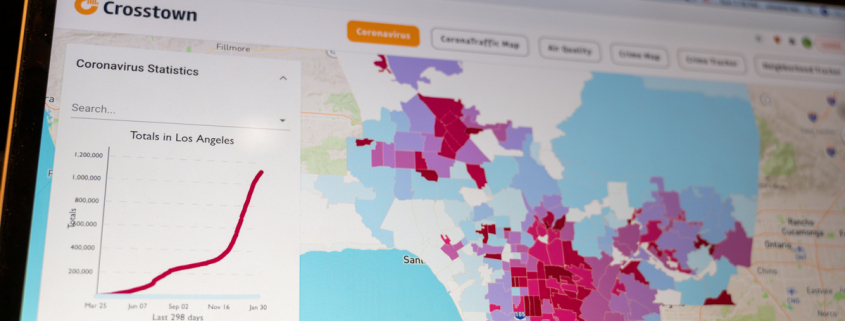‘Crosstown’ aims to revive hyper-local journalism

Gabriel Kahn, professor of professional practice of journalism at Annenberg School for Communication and Journalism, has spent the last few years trying to help the people of Los Angeles better understand their lived experiences.
Kahn is part of a project, “Crosstown,” using data to deliver hyper-local journalism in hopes of building better communities. In a few short years, this collaboration between the Annenberg school and the Integrated Media Systems Center at Viterbi School of Engineering, has built Crosstown into a platform that serves 110 unique L.A. communities. Now, Crosstown plans to expand this service to other cities in partnership with the Local Media Association and Facebook Journalism Project.
Crosstown has a uniquely scalable system. In L.A they’ve “created 110 different, unique editorial products but [they] haven’t created a system that has 110 times the costs involved for producing that,” Kahn said.
This model drives a low user acquisition cost, financially similar to what Facebook or Google might experience. The cost-reducing potential of Crosstown targets local journalism, an industry that has been plagued by “aggressive cost cutting” according to the Brookings Institute.
Crosstown will be rolling out pilot programs in three U.S. cities: Baton Rouge, La.; New Orleans, La.; and Raleigh, N.C. These pilot programs will bring the same data technology they’ve been using in L.A. for the last few years and will assess to see if this platform helps these cities to better provide for their coverage areas, and at a lower cost.
“In a sense, the scale is not a function of number of users but [of the] number of areas we cover … and that’s exactly [where] the Facebook funding [comes in],” said Cyrus Shahabi, Director of Viterbi’s Integrated Media Systems Center.
The Facebook Journalism Project, a project working to better strengthen the relationships between journalists and the communities they cover, will aid in the expansion of Crosstown, particularly supplying specialized data journalists to specific outlets located within the pilot cities.
And when it comes to the data systems Crosstown is using to power their product, they are not exactly new. In fact, the early bones of what Crosstown is today has been around at USC for a decade.
In 2011, IMSC won a contract, in partnership with USC Sol Price School of Public Policy, to develop a pipeline to better understand L.A. Metro’s traffic data. Originally used to make policy decisions, this traffic data became the first piece of data Crosstown displayed.
Shahabi and IMSC used the Metro data pipeline as the base and built new, generic searchable dashboards where journalists can easily locate information and discover trends. Soon after, they aggregated data and built dashboards for pollution, crime and coronavirus rates.
These dashboards allowed Kahn and other Crosstown journalists to not only discover city wide trends, but to see exact changes in respective neighborhoods, which may potentially differ from the larger picture. As an example, Kahn pointed out that while the City of L.A. takes in hundreds of millions of dollars a year in parking tickets, a neighborhood like Porter Ranch, 30 miles north of campus, only received four tickets.
Crosstown’s most recent development in the product became the deliverable — a newsletter.
Crosstown’s newsletter is written “mad-lib’’ style. Journalists construct the story and simple code developed by IMSC pulls the exact stats for each neighborhood, making a unique newsletter for every single data-supported area.
“You let the journalist really do what they’re good at, that is to create the news part of the story, and you give them the means to access the data just by writing some piece of text that references the data on the draft of the newsletter that then gets specialized to all the locations,” said Luciano Nocera, associate director of IMSC.
The team behind crosstown hopes their method of reporting becomes a model for other news outlets, using data to empower journalists and their upcoming pilot programs will be a major test.
“If we can figure out a way, particularly in places where coverage has disappeared, to produce coverage, cheaply, some type of coverage, have we watered areas that previously became news desserts?” Kahn said.

